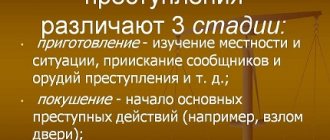The subjective side of the crime
The subjective side of the crime is the characteristics of the guilt and motive of the crime; According to Russian criminal law, without a person’s guilt, there is no corpus delicti, there can be no criminal liability and punishment.
The subjective side of a crime is the mental attitude of a person to the committed act and its consequences, in other words, it is guilt. Action or inaction is always an act of human behavior, under the control of his mind and will.
Guilt can be expressed in the form of intent or negligence.
Guilt is a person’s mental attitude towards his illegal behavior and its consequences. A necessary condition for criminal liability; expressed in forms.
Deliberate - realized (understood) the inadmissibility (illegality) of his behavior and the results associated with it and foresaw them
- Direct intent - wanted them to happen
- Indirect intent - knowingly committed
Careless - foresaw; didn't foresee it.
- Arrogance - frivolously hoping to prevent
- Negligence - should have and could have foreseen
A crime is considered committed intentionally if the person who committed it was aware of the socially dangerous nature of his action or inaction, foresaw its socially dangerous consequences and desired them or consciously allowed the occurrence of these consequences.
Irek Khabibullin beat Volodya Ivanov for allegedly being rude to him at a disco. As a result, Volodya received bodily injuries and was sick for three weeks and did not go to classes. Irek, beating Volodya, knew that he was committing an action prohibited by law, foresaw and wanted to cause harm to Volodya’s health and dignity. The investigator wrote in the decision to bring Khabibullin to criminal liability that he acted with direct intent.
A crime is considered committed through negligence if the person who committed it foresaw the possibility of socially dangerous consequences of his action or inaction, but frivolously counted on their prevention or did not foresee the possibility of such consequences, although he should have and could have foreseen them.
In the current criminal code, approximately a fifth of the articles provide for liability for careless commission of crimes. Crimes such as violations of traffic rules and operation of transport, negligence, violation of labor safety rules, careless storage of firearms and others are usually committed through negligence.
Yura and Leonid, who had recently turned sixteen, lit a fire while in the forest. It was a hot summer day. Leaving the clearing, Yura offered to put out the fire. Leonid replied that the brushwood had already burned out and it would go out on its own. Some time after they left, a wind rose, which fanned the smoldering firebrands, and a forest fire broke out from them. The boys did not foresee that a fire would break out from the extinguished fire; they did not want this. But due to their age, they should have and could have foreseen this. The guilt of Yuri and Leonid is expressed in the form of negligence.
When committing a crime, a person’s actions are determined by certain motives and are aimed at achieving certain goals. A correct assessment of any behavior is impossible without taking into account the motive and purpose. Motive and goal are mental phenomena that, together with guilt, form the subjective side of the crime .
Purpose - internal motivations of a person determined by certain needs and interests, which cause the person’s determination to commit a crime and by which he is guided when committing it, can be an aggravating or mitigating circumstance (self-interest, pity, etc.)
Motive is a mental model of the future result that a person strives to achieve when committing a crime.
An intentional crime is more dangerous than a careless one. Intentional crimes are committed seven to eight times more often than careless ones. This is evidenced by the differences in sanctions for them. For example, murder is punishable by imprisonment for up to fifteen years, and in aggravating circumstances - up to twenty years or the death penalty; causing death by negligence - imprisonment for up to three years. The danger of careless crimes should also not be underestimated. As a general rule, careless crimes are the result of frivolity, carelessness, careless handling of sources of increased danger (equipment, fire, weapons, explosives, etc.). Yes, you yourself can remember examples from literature and films when careless behavior entailed serious consequences.
Types of intent by moment of occurrence
In criminal law, in addition to direct and indirect, types of intent are distinguished by the time of occurrence (premeditated, suddenly arising) and by the degree of certainty (definite and indefinite). They cannot be defined as separate independent types of intent; they simply help to fully reveal the causes and nature of the crime.
Premeditation is one of the most dangerous, as the criminal carefully plans every action. During preparation for an offense, a certain amount of time passes, a plan, place, tools and means by which the act will be committed are considered. Such crimes are difficult to solve, since often the person who committed it leaves no traces.
Premeditated intent often poses a greater threat to society than one that suddenly arises. Basically, a person who plans a criminal act approaches this issue with special cunning and sophistication. This fact suggests that the person who committed such an offense has predominant antisocial tendencies.
Sudden intent is distinguished by the fact that the act is committed immediately after the decision is made or after a short period of time. There are two types of this intent: simple and affected.
Simple intent is manifested in the fact that the offender, when committing an offense, is in an adequate mental state and is aware of the consequences of his actions. The decision to carry out a criminal act comes suddenly or a few days before the implementation. Such crimes are usually solved quickly, since the culprit makes many mistakes and leaves traces.
Affected intent is characterized by a person’s mental state at the time of committing a crime. This means that the act was carried out when the perpetrator was in great emotional distress. The most common reason for its occurrence is the immoral and offensive attitude towards the family of the person who committed the offense. Here the greatest influence is exerted by the situation in which the crime occurred. Emotional anxiety makes it difficult for a person to think clearly, and often he does not understand what he is doing. This explains the fact of mitigation of punishment if the crime was committed with emotional intent.
Distinguish and unite
Until the laws are adjusted, it is necessary to clearly understand what the features of indirect intent are in the modern interpretation. Such awareness helps to correctly identify criminal acts, distinguishing between intent and frivolity. This is really important. Thus, if the focus of the court’s attention is a citizen responsible for the death of another, and his actions are characterized as indirect intent, it is no longer possible to talk about attempted murder or apply articles of the Criminal Code numbered 109, 111, 264 to the culprit.
Incorrect assessments and substantiation of intent within the framework of the judicial process often become the cause of mistakes by law enforcement agencies.
Continuing to look at examples
One day, the judges focused on the following situation: a citizen was accompanying buses placed on a railway platform and at one of the stations near the tracks he saw children playing with a ball. As the platform approached the station, several people began throwing stones at the buses, to which the man responded in kind, trying to protect the valuables entrusted to him. Various heavy objects came to hand and flew at the children. One of the parts, made of metal and weighing quite a lot, hit the teenager, causing severe damage to his health.
When considering the situation, the court took into account that the main goal of the subject was to prevent damage to the valuables entrusted to him. The goal is certainly positive, but in order to achieve it, the person was ready to inflict consequences classified as a serious crime. On the one hand, the subject assumed that such consequences could exist; on the other hand, he did not have a specific desire to cause harm.
How does this happen?
Some time ago, the Supreme Court revised its earlier decision regarding premeditated murder and attempted murder. Additionally, the subject was accused of manufacturing and carrying bladed weapons. When requesting a review of the case, it was decided that only indirect intent was observed in the conflict situation. Interpretations of the law state that murder can only be classified as an act characterized by direct intent. Consequently, if a different nature of intent was revealed, the decision in the case had to be completely reconsidered.
Not everything is monotonous
Examples of indirect intent from judicial practice also contain references to such events when the consequences were provoked by the absence of any actions. Moreover, the main character, without any reason, hoped that negative results simply would not occur. On the one hand, the will seems to be aimed at preventing a negative outcome, but hopes and calculations are so abstract that they have no logical explanation or basis. A good term to describe this situation is “at random.”
When analyzing what happened, the court pays special attention to assessing how much the subject of the situation realized that the consequences of the crime could be negative. In conclusion, the judge formulates to what extent the active character intended to prevent the onset of a negative result, and based on such conclusions makes a final decision on the situation.
Tax avoidance
The results of a police audit may be grounds for initiating a criminal case for tax evasion.
Investigators from the Investigative Committee of the Russian Federation are investigating tax crimes. Responsibility for this crime is provided for in Article 199 of the Criminal Code.
There are only two ways to evade taxes:
- the company did not submit a tax return or other required documents to the inspectorate
and/or
- These documents contain deliberately false information.
The first part of Article 199 of the Criminal Code provides for liability for tax evasion on a large scale, and the second part of the same article – on an especially large scale.
The amount of damage caused as a result of non-payment of taxes is determined in the absolute value of unpaid taxes, fees, insurance premiums for a period within 3 financial years in a row:
- more than 15 million rubles. - large size;
- more than 45 million rubles. - extra large size.
Example. How to calculate the amount of non-payment
In 2021, Aktiv LLC did not pay taxes in the amount of 9,000,000 rubles, in 2021 – 2,000,000 rubles, in 2021 – 3,000,000 rubles. and in 2021 – 1,000,000 rubles. The total amount of arrears is 16,000,000 rubles. Police officers cannot initiate a criminal case because the amount of arrears for 3 years in a row (from 2021 to 2021 or from 2021 to 2021) is less than 15,000,000 rubles. - accordingly 8,000,000 rubles. and 12,000,000 rub.
It is important!
The main idea of determining indirect intent is to analyze how the subject perceives possible consequences. If some illegal action is committed, where the act is a crime, its composition is completely determined by the committed, formal, then there can be no talk of intent. This concept applies exclusively to an intentionally committed act, when the consequences turn into criminal characteristics, which must be taken into account.
It must be remembered that indirect, direct intent in relation to an unlawful act with a material composition is described by two main aspects:
- awareness of the danger of what was done to society;
- anticipation of dangerous consequences for the public.
So similar and so different
It is noticeable that direct and indirect intent in criminal terms in the interpretation of legislative acts have many similarities. After conducting a detailed analysis of the mental preconditions of a particular subject regarding what was committed and the consequences of this event, one can draw conclusions on how to classify behavior. It is necessary to analyze the situation, remember the differences between frivolity and indirect intent: in the first case, the subject only abstractly understands that theoretically there could be negative consequences, and in the second option, he assumes with a high degree of probability that such an occurrence is possible.
Consciousness and foresight are classified as intellectual indicators of intent; the volitional aspect is associated with the conscious assumption of what is happening. When analyzing examples of crimes with indirect intent, attention is paid to the subject’s ability to realize how dangerous his actions or lack thereof are to the public. The crime is analyzed for a combination of strong-willed and intellectual characteristics. Based on a comparative analysis, one can conclude what is at stake in a particular case.
How it works?
You can consider real examples of indirect intent recorded in legal practice. For example, a certain person regularly drank, which led to family quarrels with his wife and children. More than once his relatives heard him threaten to set fire to the house. One day, a quarrel led to the man insisting that everyone must leave the house immediately. Having received a refusal from his family, he poured a bucket of gasoline near the burning stove. This led to a fire, and the fire immediately engulfed the entire room.
This is a good example of murder with indirect intent: the wife and son died in the hospital due to the burns they received. Another child, as well as the man himself, escaped with minor burns. Considering the situation, the court ruled that the main character did not have direct intent and did not intend to kill his relatives, but deliberately set fire to the house, which led to such tragic consequences.








